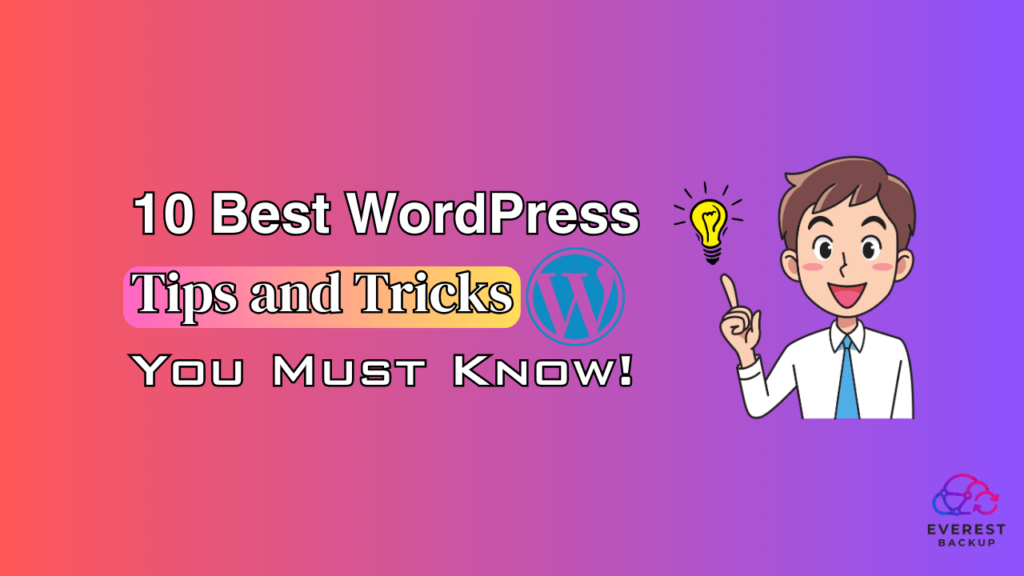If you’re a WordPress user, you already know the power and versatility of this popular website platform. But did you know that some lesser-known tips and tricks can take your WordPress experience to the next level?
This article explores the best WordPress tips and tricks for 2023, helping you optimize your website and streamline your workflow.
It’s crucial to keep up with the most recent trends and methods in web development. WordPress continues to evolve, and by familiarizing yourself with these tips and tricks, you’ll be ahead of the curve.
- Optimize your website for speed: In a fast-paced digital world, website speed is crucial. Implementing techniques such as caching, optimizing images, and choosing a lightweight theme can significantly improve your site’s loading time.
- Enhance security measures: Protecting your website from cyber threats is essential. Use tools and plugins that strengthen security precautions, such as two-factor authentication and frequent backups.
- Utilize Gutenberg blocks: The introduction of the Gutenberg editor has opened up a whole new world of possibilities for content creation. Explore the various blocks available and use them to create visually appealing and engaging pages.
- Implement SEO strategies: By using meta tags, creating XML sitemaps, and optimizing your content for relevant keywords, you may increase the visibility of your website on search engines.
- Integrate social sharing buttons: Create an easy-to-use social media sharing interface for consumers. By including social sharing buttons, you can increase the reach and engagement of your posts.
In 2023, you can grow your website to new heights by using these WordPress tips and tricks. To remain competitive in the digital environment, keep up with new developments and always update your WordPress skills.
Best WordPress tips and tricks you should know are:
1. Mastering the Block Editor:
- Exploring the Block Editor.
Gutenberg, another name for the WordPress Block Editor, is an effective tool for producing detailed and interesting content. While most users are familiar with its basic functions, there are some hidden features that can streamline your editing process. You can easily move blocks up and down using keyboard shortcuts.
- Keyboard Shortcuts for Efficiency.
To move a block up, press Ctrl + Alt + T (or Cmd + Option + T on Mac). Use Ctrl + Alt + B (or Cmd + Option + B on Mac) to move it down. You can save a lot of time by using these shortcuts when writing your article.
- Reusable Blocks for Consistency.
Another hidden gem in the Block Editor is the ability to create reusable blocks. If you have certain elements, like call-to-action sections or testimonials, that you use frequently across your site, consider turning them into reusable blocks. This ensures consistency and saves you from recreating the same content repeatedly.
2. Optimizing Images for Speed:
- Image Compression Techniques.
Images are essential for keeping your audience interested, but if not optimized, they can cause your website to load slowly. Utilize image compression plugins like Smush or EWWW Image Optimizer to reduce file sizes without sacrificing quality. You can also use the website like Tinypng or Compresspng to compress all the images.
- Lazy Loading for Faster Loading Times.
Implement lazy loading for images. Only after the user scrolls down the page will images begin to load. This can significantly improve page loading times, especially for image-heavy websites.
3. Enhancing Security:
- Two-Factor Authentication.
Security should be a top priority for any website owner. Activate two-factor authentication to increase security. This requires users to provide two verification forms before accessing the dashboard.
- Strong Password Practices.
Encourage strong password practices among your users. Passwords should be complex; changing them regularly is a good habit to prevent unauthorized access.
4. Customizing the WordPress Dashboard:
- Personalizing Your Dashboard Widgets.
Make your dashboard work for you by customizing the widgets. Rearrange and add widgets that display the information you need at a glance.
- Dark Mode for a Sleek Look.
You can enable Dark Mode for your WordPress dashboard. It not only looks sleek but can also reduce eye strain, especially during late-night editing sessions.
5. Improving SEO with Schema Markup:
- Understanding Schema Markup.
Search engines can better understand your content when schema markup is used. Learn and implement the basics in your posts to enhance your SEO efforts.
- Adding Schema Markup to Your Content.
Plugins like Yoast SEO can simplify the process of adding schema markup to your content. Utilize this to improve your search engine rankings.
6. Mastering Mobile Responsiveness:
- Mobile-Friendly Themes.
With the increasing use of mobile devices, having a mobile-responsive website is crucial. Choose themes that are mobile-friendly or use responsive design practices.
- Mobile Testing Tools.
Test your website’s mobile responsiveness using tools like Google’s Mobile-Friendly Test. It provides insights and suggestions for improvement.
7. Utilizing Advanced Custom Fields:
- Creating custom content types
Advanced Custom Fields (ACF) allows you to create custom content types easily. This is particularly useful if you have unique data requirements.
- Displaying custom fields
Display custom fields in your posts and pages to present data in a structured and organized way. ACF provides simple short codes for this purpose.
8. Essential Tips for WordPress Beginners:
- Choose the right hosting for your website.

When launching your WordPress site, choosing a reliable hosting provider is crucial for accessibility. Look for good uptime, fast loading times, strong security, and quality support. Consider your site’s needs and budget when selecting a plan. Options like Bluehost, SiteGround, and HostGator are recommended for beginners. Read this article to discover the hosting providers that are the best fit for you.
- Watch theme demos to find the perfect design.
Your website’s design is vital for attracting and engaging visitors. WordPress provides numerous themes. Before choosing one:
- Watch theme demos to assess design and functionality.
- Focus on layout, colour, typography, and user experience.
- Ensure it’s responsive for various screen sizes, including mobile.
A visually appealing, user-friendly theme sets your website apart.
- Install an SEO plugin for better optimization.
SEO is crucial for boosting website visibility and attracting organic search traffic. WordPress plugins like Yoast SEO and All in One SEO Pack offer features like keyword analysis, content optimization, XML sitemaps, and social media integration to enhance your site’s search engine ranking.
Regularly update WordPress, themes, and plugins to maintain website security and performance. Backup your site routinely to prevent data loss and prepare for unforeseen events.
9. Advanced Techniques for WordPress Beginners:
- Install Google Analytics for tracking website performance.
To understand your website’s performance, using Google Analytics is vital. This tool gives insights into traffic, user behaviour, and conversions. By monitoring metrics like page views, bounce rates, and user data, you can make informed decisions to enhance your website’s performance.
- Carefully select a theme that suits your needs.
When you begin with WordPress, picking the right theme is crucial. Themes control your website’s design and features. Research and explore options that match your brand and goals. Look for responsiveness, plugin compatibility, customization, and user-friendliness. Choose a theme that fits your needs to create an attractive, user-friendly site that represents your brand well.
Take a look at this informative article highlighting the top 10 best themes for WordPress users.
10. Expert Advice for WordPress Beginners:
Limit the number of plugins for better website performance.
When it comes to WordPress websites, it’s easy to get carried away with installing numerous plugins to enhance functionality. However, using an excessive number of plugins can harm the speed and functionality of your website. It’s important for beginners to be selective and only install plugins that are necessary for their website’s needs.
This article is a must-read for beginners who want to learn about essential starter plugins.
To optimize your website’s performance, follow these tips:
- Prioritize quality: Research and read reviews before installing plugins to ensure reliability. Avoid using redundant plugins.
- Keep plugins updated and remove unused ones: Maintain plugin updates for bug fixes and security. Delete unused plugins to prevent conflicts and boost site performance.
- Choose lightweight options: Opt for plugins designed to minimize website load time for better speed and responsiveness.
Setting up your Gravatar for a professional online presence:
A Gravatar is a universally recognizable avatar that follows you on different websites. It allows you to establish a consistent online presence by associating a profile picture with your email address. When you comment on WordPress sites or participate in forums, your Gravatar will be displayed next to your name.
To set up your Gravatar:
- Create a Gravatar account: Visit the Gravatar website and sign up with the same email address you use for your WordPress site.
- Upload your profile picture: Choose a professional headshot or a photo that reflects your brand. Make sure the image is clear and represents you well.
- Verify your email: Gravatar will email you to verify your account. Follow the instructions in the email to complete the verification process.
Conclusion:
WordPress is a dynamic platform that continuously evolves to meet the needs of its users. By implementing these lesser-known tips and tricks, you can take your WordPress experience to the next level. From enhancing security to optimizing for voice search and improving mobile responsiveness, You can stay on top in the rapidly evolving digital environment by using these tactics.
